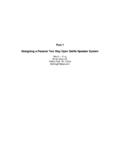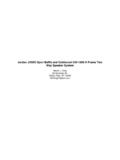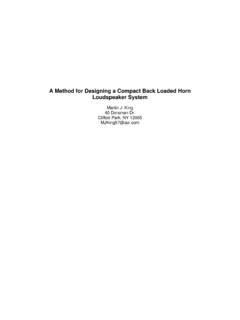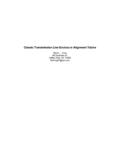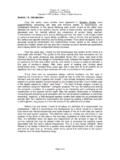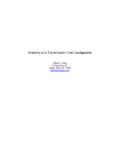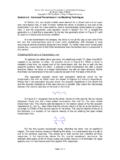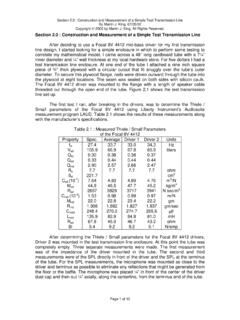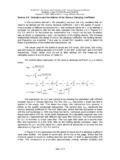Transcription of Part 2 Designing a Passive Two Way Open Baffle …
1 part 2. Designing a Passive Two Way open Baffle speaker system Martin J. King 40 Dorsman Dr. Clifton Park, NY 12065. part 2 : Designing a Passive Two Way open Baffle speaker system By Martin J. King, 01/05/16 (Revised 06/28/16). Copyright 2016 by Martin J. King. All Rights Reserved. Introduction : When I wrote part 1 of this article there weren't many DIY OB designs available on the Internet. The original article was intended only as a study of the trade-offs required to design a two-way Passive crossover OB speaker system . The simulations I. ran for the original design used manufacturer's specifications for the FE-103E full range driver, I did not have measured values, and measured parameters for the Eminence Alpha 15A woofer. Other Fostex full range drivers were mentioned as potential candidates but no simulation results were included. Much to my surprise, quite a few people built the original design and a few of these finished speakers can be seen in my web site's gallery.
2 For the most part the feedback was very positive. While there were a few people who were critical of some aspect in the design the majority of builders seemed to be pleased and provided good constructive feedback. I built my own version a few years ago using a dBx active crossover, maintaining the same crossover philosophy, and tried many of the Fostex small full range drivers along with offerings from Jordan, Mark Audio, and Fountek. In the past couple of years, the FE-103E was discontinued and replaced by the FE-103En. As implied above, my collection of Fostex drivers has also expanded and I. now have measured T/S parameters for most of the small Fostex full range drivers that can be used in this two-way Passive OB speaker design. I decided it was time to provide an update, so now I have the original part 1 article and this newer part 2 article. Design Discussion : Since the original article, written in 2007, I have experimented with a number of different dipole speakers featuring a variety of woofers and full range drivers.
3 Each speaker system was designed using my MathCad worksheets and the individual driver's measured T/S parameters. Upon completion of the builds, the SPL response curves were measured and compared to the predictions from the MathCad worksheets. The correlations continually improved as the worksheets were revised and upgraded based on what I was learning. Some of the lessons learned about this particular style of OB design, using a Passive crossover, are listed below The dB output for volts is very important when selecting drivers and is not always provided by manufacturers. Having this value for all drivers makes the selection and design process much more straight forward. The Eminence Alpha 15A woofer is measured to be dB/watt/m. This converts to volts/m. The full range driver goal should be ~ volt/m for this size Baffle . This is dB below the woofer's value. Inserting an L-Pad circuit into the crossover makes more efficient full range drivers fit the recipe.
4 Many tube amps struggle with this crossover filter design; bass can be very recessed compared to using a solid state amp. If possible, try your tube amp but be ready to switch to a SS amp if necessary. Page 1 of 8. part 2 : Designing a Passive Two Way open Baffle speaker system By Martin J. King, 01/05/16 (Revised 06/28/16). Copyright 2016 by Martin J. King. All Rights Reserved. Figure 2, in part 1, shows the Baffle layout for a Fostex full range driver paired with an Eminence Alpha 15A woofer. The Baffle is 20 wide and 38 tall. The woofer is centered 10 above the bottom. The full range driver is 32 above the bottom of the Baffle and shifted 2 off center; this arrangement requires a mirror image construction. I have accumulated a significant collection of full range drivers from different manufacturers and have measured the T/S parameters for each pair. Looking at just the Fostex drivers below 5 in diameter, I found eight that worked well in this style of Passive OB speaker system .
5 I am sure that there are many other full range drivers that would also work but these were the best candidates from what I have on hand. Table 4. contains the measured T/S parameters for the drivers used in this study. Table 4 : Measured T/S Parameters for Eminence and Fostex Drivers Driver Alpha 15A Units fs 41 Hz Re ohm Qed - Qmd - Qtd - Vad 260 liter BL N/amp Sd cm^2. SPL dB. Unit Cost US $'s Driver FF85WK FE103En FF105WK FE108E Units fs Hz Re ohm Qed - Qmd - Qtd - Vad liter BL N/amp Sd cm^2. SPL dB. Unit Cost US $'s Driver F120A FE126En FF125WK FX120 Units fs Hz Re ohm Qed - Qmd - Qtd - Vad liter BL N/amp Sd cm^2. SPL dB. Unit Cost US $'s Page 2 of 8. part 2 : Designing a Passive Two Way open Baffle speaker system By Martin J. King, 01/05/16 (Revised 06/28/16). Copyright 2016 by Martin J. King. All Rights Reserved. Figure 14 contains the schematics and the circuit values for the second order two-way crossovers.
6 The circuit for the Eminence Alpha 15A woofer is constant but the filters for the individual Fostex drivers vary. Each Fostex driver, except the FF85WK, also has a pair of resistors, one in series and one in parallel with the driver, to form an L- Pad which attenuates the SPL output to meet the desired ~ value. Figure 14 : Passive Crossover Definitions Driver L2 C2 R_series R_parallel Alpha 15A - - Units mH uF ohms ohms Driver C1 L1 R_series R_parallel FF85WK - - FE103En FF105WK FE108E F120A FE126En FF125WK FX120 Units uF mH ohms ohms Inductors are ERSE Super Q 16 AWG. Capacitors are Solen Resistors are Mills Page 3 of 8. part 2 : Designing a Passive Two Way open Baffle speaker system By Martin J. King, 01/05/16 (Revised 06/28/16). Copyright 2016 by Martin J. King. All Rights Reserved. Calculated Results : Using the measured T/S parameters and the crossovers shown in Figure 14, I. ran simulations of the OB speakers and plotted the SPL responses at the tradition 1 m distance and also at 3 m to simulate a real listening distance.
7 All of the different Fostex drivers produced approximately the same calculated SPL response once the levels were adjusted by the L-Pads. Figure 15 shows the anechoic woofer SPL contribution at 1 m and at 3 m distances on the axis of the full range driver. The dashed lines in the plots are the woofer's infinite Baffle response, the Baffle response, and the crossover response. All three curves contribute to the final woofer response shown by the solid red line. The differences between the 1 m and 3 m result is due to the woofer directivity which starts to come into play at about 100 Hz, the 1 m SPL response is starting to roll off. The 3 m result is probably more typical of what the listener hears, this is something I did not consider in part 1 of the article. Figure 16 shows the anechoic OB system SPL response at 1 m and 3 m distances on the axis of the full range driver. The woofer contribution is shown as the dashed red line, the full range driver contribution is shown as the dashed blue line, and the final combined system SPL response is shown as the solid red line.
8 At the larger 3 m distance the directivity of the woofer is reduced as well as the directivity associated with the Baffle edge sources. The lower plot in Figure 13, the 3 m distance, is my design goal yielding a slightly decreasing SPL output as you go up in frequency as opposed to a perfectly flat SPL curve. I found in previous OB speaker designs that a small reduction in output as frequency increases produced the best sounding system in my listening room. The L-Pad values can easily be adjusted to increase or decrease the SPL downward tilt. Finally, in Figure 17 are the anechoic horizontal and vertical polar responses at the acoustic crossover frequency seen in Figure 16. These plots are generated at the 3. m distance in 1 degree increments around the speaker . As can be seen in the lower plot the crossover generated null is directed along the floor. For points above 0 degrees, the potential listening positions, the SPL response is pretty uniform.
9 All of the Fostex drivers listed in Table 4 produced similar SPL responses using the crossovers defined in Figure 14. Note that the modeled results do not include any of the driver cone break-up peaks and dips so these need to be considered when deciding which Fostex driver is the best choice for your listening room and equipment. I think the differences in the sound of this OB design will primarily be driven by the full range driver selection. If the builder wants a hotter more aggressive sound, then probably one of the Fostex FE series is the right selection. If a more laid back sound is desired, then maybe one of the Fostex FF drivers is a better selection. The basic sound of the OB system should be the same for all of the Fostex drivers but some voicing is poss ible by selecting one driver model over another. Page 4 of 8. part 2 : Designing a Passive Two Way open Baffle speaker system By Martin J.
10 King, 01/05/16 (Revised 06/28/16). Copyright 2016 by Martin J. King. All Rights Reserved. Figure 15 : Anechoic Woofer SPL Output at 1 m and 3 m on the Full Range Driver Axis Page 5 of 8. part 2 : Designing a Passive Two Way open Baffle speaker system By Martin J. King, 01/05/16 (Revised 06/28/16). Copyright 2016 by Martin J. King. All Rights Reserved. Figure 16 : Anechoic system SPL Output at 1 m and 3 m on the Full Range Driver Axis Page 6 of 8. part 2 : Designing a Passive Two Way open Baffle speaker system By Martin J. King, 01/05/16 (Revised 06/28/16). Copyright 2016 by Martin J. King. All Rights Reserved. Figure 17 : system SPL Polar Response at 3 m on the Full Range Driver Axis Page 7 of 8. part 2 : Designing a Passive Two Way open Baffle speaker system By Martin J. King, 01/05/16 (Revised 06/28/16). Copyright 2016 by Martin J. King. All Rights Reserved. Conclusions : A Passive two way OB speaker system is possible with careful selection of the woofer and a full range driver.
